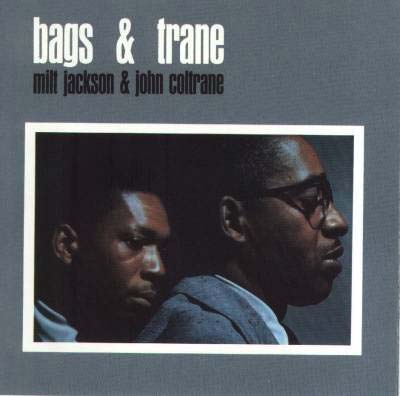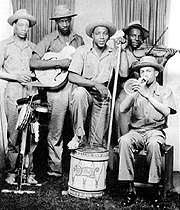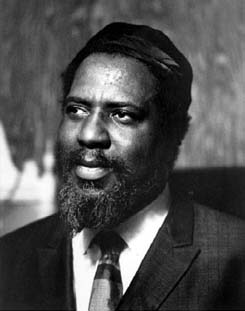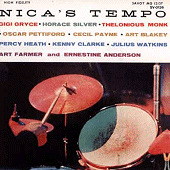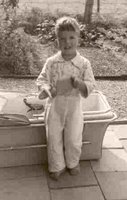
There are several ways to make a film about jazz. It is obvious to start with the documentary, using original shots with the original musicians; colleagues tell their stories about the subject of the film. A good example is Ken Burns's Jazz. That's not the type of film I want to talk about; I want to draw a parallel between films that use actors and do have a story. There are several classical examples, like Hello Dolly or Young Man With A Horn, but I love to introduce you some films that were released in the 1990s like Kansas City, Bird and Round Midnight; Three, complete different, productions I have in my collection.
This third item is about Herbie Hancock's Round Midnight.
Like Bird, Round Midnight wants to create a film about the life of a jazz musician. This time it seems Bud Powell, the bebop piano player. The name of Bud Powell doesn't appear in the film, the central figure Dale Turner isn't even a piano player. Dale Turner, played in an unsurpassed way by Dexter Gordon, is a US sax player, who performs in the Blue Note club in Paris, becomes friends with a French photographer who is able to keep him off from excessive drinking. Due to the fact that this film didn't want to be the a story of the life of one particularry jazz man, elements suggest that in was based on Bud's life.

The acting of Dexter Gordon is great - he doesn't play a role - his appearance is natural and he seems to be a born film actor. The concerts are great, the music arranged by Herbie Hancock, who is the piano player in most scenes, always sound natural and you never have the feeling looking to an arranged scene in a film. Other great names are Wayne Shorter, Ron Carter, Freddie Hubbard, Cedar Walton and Bobby Hutcherson. The Paris sessions also include great French musicians like Pierre Michelot.
If you have the opportunity try to find this film and enjoy it.
ROUND MIDNIGHT - France/USA 1986 – f dir Bertrand Tavernier
Music by: Herbie Hancock Music Directed/Conducted by: Herbie Hancock Henri Renaud, (assistant) Dexter Gordon Music Arranged by: Herbie Hancock Songs: Recorded 28th January 1986 in Paris: "’Round midnight" by Thelonious Monk, Bernie Hanighen, Cootie Williams, "Chan’s song" by Herbie Hancock, Stevie Wonder, "What is this thing called love" by Cole Porter, performed by Herbie Hancock, pno; Ron Carter, b; Tony Williams, drs; Bobby McFerrin,voc; "‘Round midnight" performed by Herbie Hancock, solo pno; "Watermelon man" by Herbie Hancock, performed by Herbie Hancock,pno; Ron Carter, b; Tony Williams, drs. Recorded 29th January 1986 in Paris: "I cover the waterfront" by Edward Heyman, Johnny Green, "What is this thing called love", "Now’s the time" by Charlie Parker, "I cover the waterfront" (with Guy Marchand, voc), per-formed by Henri Renaud, pno; Jimmy Gourley, gtr; Michel Gaudry, b; Philippe Combelle, drs; "Autumn in New York" by Vernon Duke, per-formed by Henri Renaud, pno; Michel Gaudry, b; Philippe Combelle, drs; "How long has this been going on?" by George and Ira Gershwin, performed by Jimmy Gourley, voc, gtr; Michel Gaudry, b; Philippe Combelle, drs. "Body and soul" by Edward Heyman, Robert Sour, Frank Eyton, John Green, performed by Dexter Gordon, ts; Herbie Hancock, pno; John McLaughlin, gtr; Pierre Michelot, b; Billy Higgins, drs; "Bérangère’s nightmare" by Herbie Hancock, performed by Herbie Hancock, pno; John McLaughlin, gtr; Pierre Michelot, b; Billy Higgins, drs; "Fair weather" by Kenny Dorham, performed by Chet Baker, tpt, voc; Herbie Hancock, pno; Pierre Michelot, b; Billy Higgins, drs; "Una noche con Francis" by Bud Powell, performed by Dexter Gordon, Wayne Shorter, ts; Bobby Hutcherson, vibs; Herbie Hancock, pno; Pierre Michelot, b; Billy Higgins,drs; "The peacocks" by Jimmy Rowles, performed by Wayne Shorter, sop sax; Herbie Hancock, pno; Pierre Michelot, b; Billy Higgins,drs; "How long has this been going on?" by George and Ira Gershwin, performed by Dexter Gordon, ts; Herbie Hancock, pno; Pierre Michelot, b; Billy Higgins, drs; Lonette McKee,voc; "Rhythm-a-ning" by Thelonious Monk, performed by Freddie Hubbard, tpt; Dexter Gordon, ts; Cedar Walton, pno; Ron Carter, b; Tony Williams, drs; "Still time" by Herbie Hancock, performed by Dexter Gordon, ts; Herbie Hancock, pno; Pierre Michelot, b; Billy Higgins, drs; "Minuit aux Champs-Elysées" by Henri Renaud, performed by HerbieHancock, pno; Bobby Hutcherson, vibs; "As time goes by" by Herman Hupfeld; "SocietyRed" by Dexter Gordon; "It’s only a paper moon" by Billy Rose, E. Y. Harburg, Harold Arlen; "Tivoli" by Dexter Gordon; "Put it right here" by Bessie Smith, performed by Sandra Reaves-Phillips; "I love Paris" by Cole Porter; "I love a party" by Herbie Hancock, Chan Parker.With: Dexter Gordon as Dale Turner, Lonette McKee as Darcey Leigh, Herbie Hancock as Eddie Wayne, Bobby Hutcherson as Ace, Hart Leroy Bibbs as Hershell, Victoria Gabrielle Platt as Chan, Martin Scorsese as Goodley. At the Blue Note: Wayne Shorter, ts; Eric Le Lann, tpt; John McLaughlin, gtr; Bobby Hutcherson,vibs; Pierre Michelot, b; Billy Higgins, drs. At the Studio Davout: Wayne Shorter, sop sax; Palle Mikkelborg, tpt; Mads Vinding, Ron Carter, b; Billy Higgins, drs. In Lyon: Wayne Shorter, sop sax; Michel Perez, gtr; Mads Vinding, b; Tony Williams, drs; Cheikh Fall, perc. In New York: Freddie Hubbard, tpt; Cedar Walton, pno; Ron Carter, b; Tony Williams, drs. "This film is respectfully dedicated to Bud Powell and Lester Young" but, despite being fictionally plotted, is obviously inspired by the story of Bud Powell’s Paris friendship with Francis Paudras to the extent of including a character called Herschel dying in an hotel room, a girl called Chan, a woman called Buttercup,a singer who wears a white gardenia in her hair, a tenor sax addressed as Sweets, a sleazy manager called Oscar Goodley, and so on...(source: Jazz in the Movies - David Meeker)
The other two film discussed are Kansas City and Bird
 I received a link from Enrico B. with a very nice promotional short made for Irving Mills' short-lived Master and Variety labels. I love to share this film with you.
I received a link from Enrico B. with a very nice promotional short made for Irving Mills' short-lived Master and Variety labels. I love to share this film with you.



